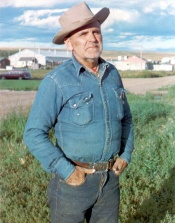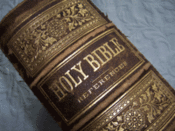Sandbox: Difference between revisions
No edit summary |
No edit summary |
||
| Line 1: | Line 1: | ||
<!-- The Sandbox - Don't change or erase this text - it won't show up on your preview --> | <!-- The Sandbox - Don't change or erase this text - it won't show up on your preview --> | ||
{| style="width:800px" | {| style="width:800px" | ||
| | | | ||
<div style="text-align:Center; padding:2px; margin:1px;"><font color='#800000' size='+3'> | |||
''' | '''[[The Message|The Message of William Branham]]'''<br></font> </div> | ||
<div style="border-bottom:2px #B87333 solid; text-align:Center; padding:2px; margin:1px;"><font color='#800000' size='+3'> | |||
Examine it. [[A Challenge to Message Believers|Test it.]] You Decide.<br></font><font color='#800000' size='+0'> | |||
(And, please, don't take our word for it. Search it out yourself.) | |||
</font> </div> | |||
'''An Objective Review of the Message and Ministry of William Branham.''' | |||
{{col-begin}} | |||
{{col-break}} | |||
William Marrion Branham was a minister whose healing ministry in the late 1940's skyrocketed him from a rural pastor to an international evangelist. His controversial teachings have divided his legacy into three main views: | |||
1) Some believe him to be Elijah the Prophet in fulfillment of Malachi 4:5. Some view his every word as infallible, while others only accept his "Thus Saith The Lord" teachings as infallible. | |||
2) Some view him as a great evangelist who left Christian orthodoxy in the 1950's and 60's. | |||
3) Some view him as a charlatan. | |||
The purpose of BelieveTheSign is to provide objective and first-hand information on William Branham's life, his claims, the beliefs of his followers, and the criticisms of his detractors. | |||
{{col-break}} | |||
{|style="width:450px; border:1px solid #E8B399;background-color:#F0DCC8;vertical-align:top; text-align:left;" | |||
| | |||
<mediaplayer width='440' height='320'>http://www.youtube.com/watch?v=raWhgy6649o</mediaplayer> | |||
|- | |||
|} | |||
{{col-end}} | |||
{|style="border-spacing:8px;margin:0px -8px" | |||
<!-- Start of first-column --> | |||
|class="MainPageBG" style="width:195px;height:150;border:1px solid #cedff2;background-color:#f5faff;vertical-align:top"| | |||
{| width="100%" cellpadding="2" cellspacing="5" style="vertical-align:top;background-color:#f5faff" | |||
! <h2 style="margin:0;background-color:#cedff2;font-size:120%;font-weight:bold;border:1px solid #a3b0bf;text-align:left;color:#000;padding:0.2em 0.4em;">Humble Pie</h2> | |||
|- | |||
|{{Click || image=PieOK.jpg|link=Humble Pie|width=175px|height=110px}} | |||
*'''[[Humble Pie]]''' | |||
*[[What's New]]? | |||
*[[BelieveTheSign:About|Who are we?]] | |||
*[[A Challenge to Message Believers|Take The Test!]] | |||
*[[If you need help]]... | |||
*[http://www.facebook.com/BelieveTheSign Facebook discussion] | |||
|- | |||
|} | |||
{| width="100%" cellpadding="2" cellspacing="5" style="vertical-align:top;background-color:#f5faff" | |||
! <h2 style="margin:0;background-color:#cedff2;font-size:120%;font-weight:bold;border:1px solid #a3b0bf;text-align:left;color:#000;padding:0.2em 0.4em;">Twisted Theology</h2> | |||
|- | |||
|{{Click ||image=7-church-ages-diagram-small.jpg|width=175px|height=110px|link=Matthew 17:11}} | |||
*[[Progressive Revelation]] | |||
*[[The Prophet and The Eagle|Prophets and Eagles]] | |||
*[[Matthew 17:11]] | |||
*[[Enoch and Noah]] | |||
*[[Matthew 24:28]] | |||
*[[Three holy words|The Secret Formula]] | |||
*[[Tithing]] | |||
|- | |||
|} | |||
<!-- Start of second-column --> | |||
|class="MainPageBG" style="width:195px;height:150;border:1px solid #cedff2;background-color:#f5faff;vertical-align:top"| | |||
{| width="100%" cellpadding="2" cellspacing="5" style="vertical-align:top;background-color:#f5faff" | |||
! <h2 style="margin:0;background-color:#cedff2;font-size:120%;font-weight:bold;border:1px solid #a3b0bf;text-align:left;color:#000;padding:0.2em 0.4em;">William Branham</h2> | |||
|- | |||
|{{Click ||image=Image-rs-131 - BR Branham1.jpg|width=175px|height=110px|align=top|link=William Branham}} | |||
*[[William Branham|Life Story]] | |||
*[[The Message#Is the message a cult?|Cult founder?]] | |||
*[[Sensational Documents]] | |||
*[[THUS SAITH THE LORD|Thus saith the Lord?]] | |||
*[[Eyewitnesses]] | |||
*[[Healings]] | |||
|- | |||
|} | |||
{| width="93%" cellpadding="2" cellspacing="5" style="vertical-align:top;background-color:#f5faff" | |||
! <h2 style="margin:0;background-color:#cedff2;font-size:120%;font-weight:bold;border:1px solid #a3b0bf;text-align:left;color:#000;padding:0.2em 0.4em;">Prophecy</h2> | |||
|- | |||
|{{Click || image=eagle.jpg|link=Prophecy|width=175px|height=110px}} | |||
*[[Prophecy|Prophecies]] | |||
*[[Proof of the Prophetic]] | |||
*[[Plagiarism|Plagiarism]] | |||
*[[A Challenge to Message Believers|No real prophecies?]] | |||
|- | |||
|} | |||
< | <!-- Start of third-column --> | ||
The | |class="MainPageBG" style="width:195px;height:150;border:1px solid #cedff2;background-color:#f5faff;vertical-align:top"| | ||
{| width="100%" cellpadding="2" cellspacing="5" style="vertical-align:top;background-color:#f5faff" | |||
! <h2 style="margin:0;background-color:#cedff2;font-size:120%;font-weight:bold;border:1px solid #a3b0bf;text-align:left;color:#000;padding:0.2em 0.4em;">Articles With Videos</h2> | |||
|- | |||
|{{Click ||image=Video Cover.jpg|link=Video Resources|width=175px|height=110px}} | |||
*[[The Municipal Bridge Vision|Failed Bridge Vision]] | |||
*[[The Vision of the Meetings in South Africa|Failed Africa Prophecy]] | |||
*[[The Brown Bear Vision|Failed Hunting Vision]] | |||
*[[1933 Ohio River Experience|The Ohio River Voice]] | |||
*[[Prophecy of the Cloud|The Arizona Cloud Part 1]] | |||
*[[The Cause of the Cloud|The Arizona Cloud Part 2]] | |||
*[[Hagin Prophecy|The Hagin Prophecy]] | |||
*[[Roy Davis|Honesty - Part 1]] | |||
*[[Was William Branham Honest|Honesty - Part 2]] | |||
*[[The Man from Windsor|Honesty - Part 3]] | |||
*[[An Uncertain Sound|Uncertain Teaching]] | |||
*[[Marriage and Divorce|Teaching on Divorce]] | |||
*[[Fallen From Grace|What Paul Preached?]] | |||
*[[Are There Women Angels?|Women Angels]] | |||
*[[Michael the Archangel|Michael the Archangel]] | |||
*[[Edward Byskal|Message Ministers 1]] | |||
*[[Failed Prophecies|Message Ministers 2]] | |||
*[[The History of Believe The Sign|Our History Part 1]] | |||
*[[The History of Believe The Sign - Part 2|Our History Part 2]] | |||
*[[Errors in the New Testament|Bible Errors?]] | |||
|- | |||
|} | |||
<!-- Start of Fourth-column --> | |||
|class="MainPageBG" style="width:195px;height:150;border:1px solid #cedff2;background-color:#f5faff;vertical-align:top;"| | |||
{|width="100%" cellpadding="2" cellspacing="5" style="vertical-align:top;background-color:#f5faff" | |||
! <h2 style="margin:0;background-color:#cedff2;font-size:120%;font-weight:bold;border:1px solid #a3b0bf;text-align:left;color:#000;padding:0.2em 0.4em;">Languages</h2> | |||
|- | |||
|style="color:#000"|{{Click || image=nav_globe.jpg|link=Main Page|width=100px|height=110px|center}} | |||
*[[Afrikaans]] | |||
*[[Asante Twi]] | |||
*[[Bulgarish]] | |||
*[[Cebuano]] | |||
*[[Dutch]] | |||
*[[Español]] | |||
*[[French]] | |||
*[[Hindi]] | |||
*[[Italian]] | |||
*[[Luganda]] | |||
*[[Norwegian]] | |||
*[[Português]] | |||
*[[Romanian]] | |||
*[[Runyankole]] | |||
*[[Russian]] | |||
*[[Swedish]] | |||
*[[Tagalog]] | |||
*[[Tswana]] | |||
*[[Turkish]] | |||
*[[Zulu]] | |||
|- | |||
|} | |||
|} | |||
* | {|style="border-spacing:8px;margin:0px -8px" | ||
* | <!-- Start of eighth-column --> | ||
* | |class="MainPageBG" style="width:195px;height:150;border:1px solid #cedff2;background-color:#f5faff;vertical-align:top"| | ||
{| width="100%" cellpadding="2" cellspacing="5" style="vertical-align:top;background-color:#f5faff" | |||
! <h2 style="margin:0;background-color:#cedff2;font-size:120%;font-weight:bold;border:1px solid #a3b0bf;text-align:left;color:#000;padding:0.2em 0.4em;">The Cloud</h2> | |||
|- | |||
|{{Click ||image=Cloud.jpg|width=175px|height=110px|link=The Cloud}} | |||
*[[The Cloud]] | |||
*[[Prophecy of the Cloud|The Prophecy]] | |||
*[[Rattlesnake Mesa|The Location]] | |||
*[[The Cause of the Cloud|The Cause]] | |||
*[[The Timing of Cloud Events|Timing]] | |||
|- | |||
|} | |||
< | <!-- Start of twelvth-column --> | ||
|class="MainPageBG" style="width:195px;height:150;border:1px solid #cedff2;background-color:#f5faff;vertical-align:top"| | |||
{| width="100%" cellpadding="2" cellspacing="5" style="vertical-align:top;background-color:#f5faff" | |||
! <h2 style="margin:0;background-color:#cedff2;font-size:120%;font-weight:bold;border:1px solid #a3b0bf;text-align:left;color:#000;padding:0.2em 0.4em;">Strange Doctrine</h2> | |||
|- | |||
|{{Click || image=Bible_Revelation.gif|link=Condensed List of Issues with the Message#Doctrinal/Biblical Issues|width=175px|height=110px}} | |||
*[[Lazy Theology]] | |||
*[[The Godhead]] | |||
*[[The Serpent's Seed]] | |||
*[[Marriage and Divorce]] | |||
*[[Christians that were required to believe Satanic doctrine|Christians that had to believe Satan to be saved?]] | |||
|- | |||
|} | |||
<!-- Start of eleventh-column --> | |||
|class="MainPageBG" style="width:195px;height:150;border:1px solid #cedff2;background-color:#f5faff;vertical-align:top"| | |||
{| width="100%" cellpadding="2" cellspacing="5" style="vertical-align:top;background-color:#f5faff" | |||
! <h2 style="margin:0;background-color:#cedff2;font-size:120%;font-weight:bold;border:1px solid #a3b0bf;text-align:left;color:#000;padding:0.2em 0.4em;">Invitation</h2> | |||
|- | |||
|{{Click ||image=Baptism Sakhalin.jpg|width=175px|height=110px|link=Invitation to Eternal Life}} | |||
*[[What does God want from me?|What does God want?]] | |||
*[[Why should I care?]] | |||
*[[Invitation to Eternal Life]] | |||
*[[Water Baptism]] | |||
|- | |||
|} | |||
<!-- Start of seventh-column --> | |||
|class="MainPageBG" style="width:195px;height:150;border:1px solid #cedff2;background-color:#f5faff;vertical-align:top"| | |||
{| width="100%" cellpadding="2" cellspacing="5" style="vertical-align:top;background-color:#f5faff" | |||
! <h2 style="margin:0;background-color:#cedff2;font-size:120%;font-weight:bold;border:1px solid #a3b0bf;text-align:left;color:#000;padding:0.2em 0.4em;">Research Material</h2> | |||
|- | |||
|{{Click ||image=Book-stack.jpg|width=175px|height=110px|link=Research Sources for William Branham and His Message}} | |||
: | *[[Condensed List of Issues with the Message|Full list of issues]] | ||
*[[Research Sources for William Branham and His Message|Research Sources]] | |||
*[[A Logical Refutation of Branham's Message|Nathan Rivera]] | |||
*[[Legend of the Fall]] | |||
*[[Seek Ye The Truth]] | |||
*[http://www.facebook.com/BelieveTheSign Discussion Forum] | |||
|- | |||
|} | |||
|} | |||
{|style="width:800px; background-color:#cedff2; border:1px #a3b0bf solid; text-align:center;" | |||
|''Have I then become your enemy by telling you the truth?'' (Galatians 4:16 ESV) | |||
|} | |||
If you see anything on this website that you believe to be inaccurate or misleading, please let us know. We pray that the contents of this website would speak to your soul, and lead you closer to Jesus Christ. | |||
= | __NOTOC__ __NOEDITSECTION__ | ||
{|style="width:800px;background-color:transparent;margin-top:-.8em;margin-bottom:-.7em" | |||
|style="font-size:95%;text-align:left;white-space:nowrap;color:#000"| | |||
|style="font-size:95%;padding-top:10px;padding-bottom:10px;margin:0px;text-align:right;white-space:nowrap;color:#000"| | |||
[[Contact information|Contact us]] | |||
| | |||
|} | |} | ||
Revision as of 21:05, 26 December 2013
|
Examine it. Test it. You Decide. An Objective Review of the Message and Ministry of William Branham.
If you see anything on this website that you believe to be inaccurate or misleading, please let us know. We pray that the contents of this website would speak to your soul, and lead you closer to Jesus Christ.
|









